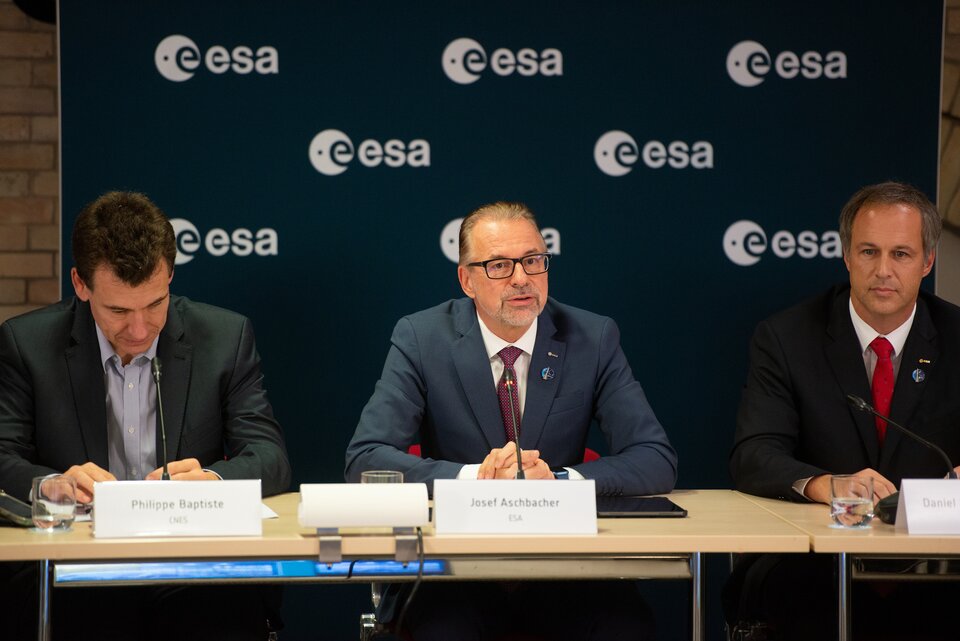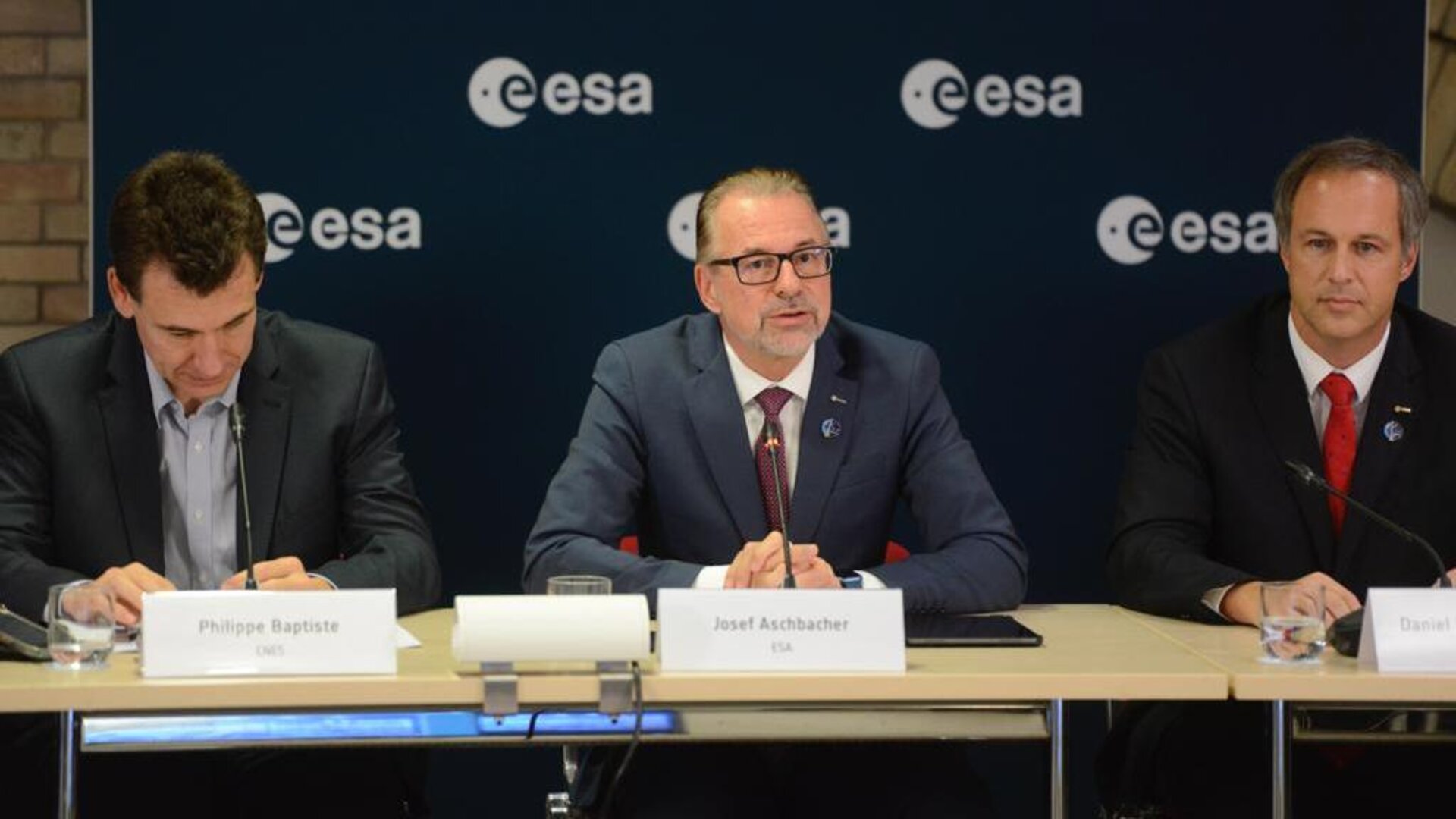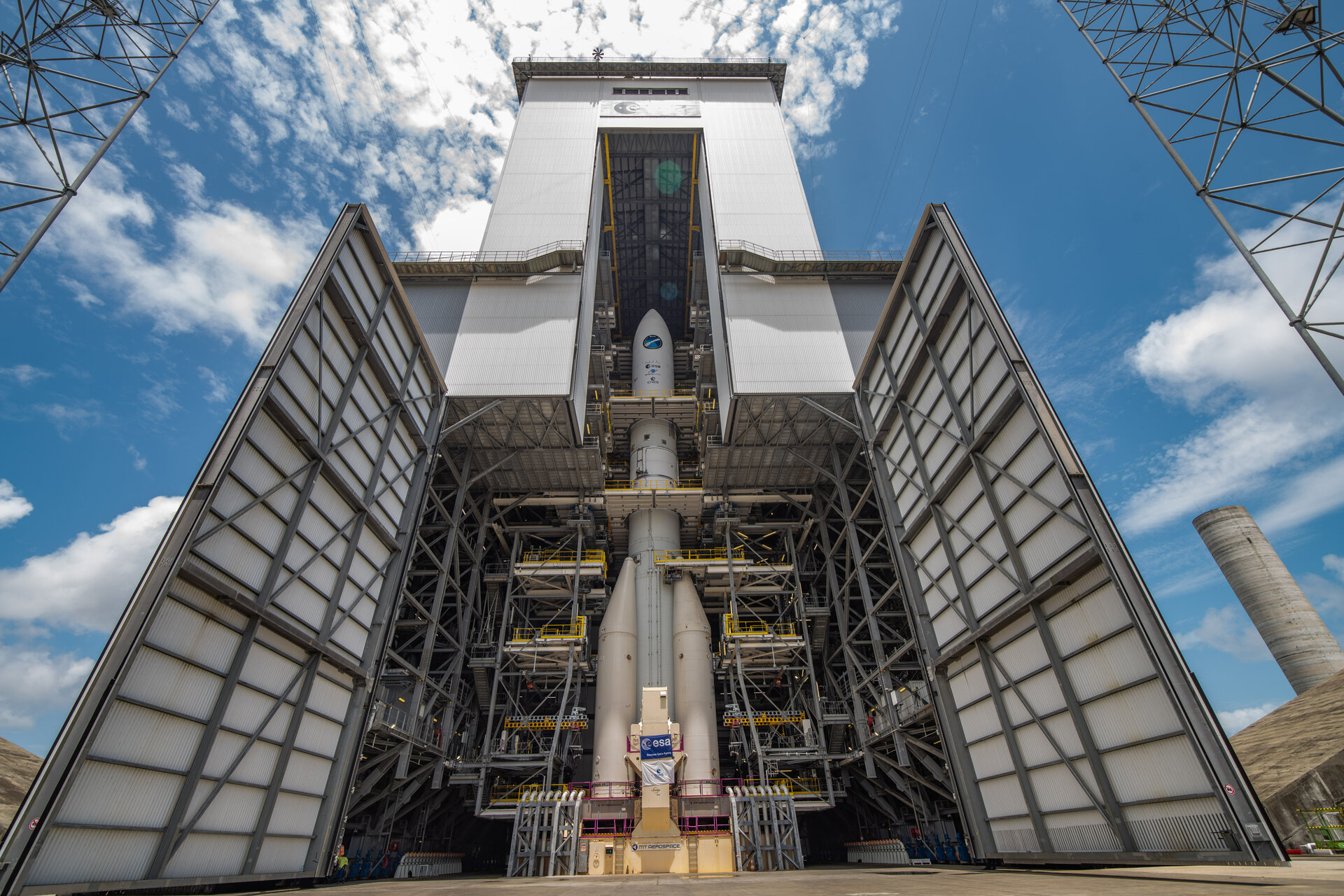Ariane 6 first flight planned for fourth quarter of 2023
Ariane 6, the new heavy-lift launch system being developed by the European Space Agency, will make its inaugural flight as soon as the fourth quarter of 2023. Briefing media gathered at ESA’s Paris Bertrand headquarters on 19 October, Director General Josef Aschbacher said sufficient progress had been made over the past several months to anticipate a Q4 2023 first flight, pending the realization of three key milestones before April next year.
Aschbacher was joined by ESA’s Director of Space Transportation, Daniel Neuenschwander, and the heads of ESA’s Ariane 6 partners: André-Hubert Roussel, chief executive of launcher system industrial prime contractor ArianeGroup; Stéphane Israël, chief executive of launch services provider Arianespace; and Philippe Baptiste, chief executive of CNES, the French space agency which administers Europe’s Spaceport in French Guiana and is responsible for development and operations of the Ariane 6 launch base.
Aschbacher explained that recent progress has made it possible to plan for an inaugural Ariane 6 launch during the final quarter of 2023 – but, he stressed: “With a project of this magnitude it needs to be clear that this is a planned date and the programme will still need to make the successful and timely achievement of a number of key milestones for this schedule to remain valid.”
Specifically, he said, three critical milestones must be achieved by the first quarter of 2023. One is the successful completion of the upper stage hot firing test campaign begun earlier this month at the engine and stage testing centre of Germany’s DLR aerospace agency in Lampoldshausen.
A second critical milestone will be to begin hot firing tests of Ariane 6’s core stage, with its Vulcain 2.1 engine, on the launch pad in French Guiana. Vulcain 2.1 hot-firing tests are part of the so-called combined test campaign to validate the rocket and launch pad as a unified system. That campaign is now moving forward, as full stacking on the launch pad of a complete test model of Ariane 6 was realized earlier this month.
Finally, said Aschbacher, this inaugural launch plan depends on the start of the launch system qualification review also by the first quarter of 2023.
He concluded: “What is at stake here is European independent access to space. We are all fully committed to proceeding as speedily as possible to the launch pad.”

ArianeGroup chief executive André-Hubert Roussel underscored recent Ariane 6 development milestones on the test bench at Lampoldshausen and in the assembly buildings and on the launch pad in French Guiana. In French Guiana, to have fully stacked a test model of Ariane 6 shows that the mechanical interfaces between rocket and launch pad are successful. The next goal is to demonstrate the same for electrical and fluid connections, and to ensure the ground infrastructure and launcher communicate properly up to the moment of liftoff.
And, he added, the programme marked an “extremely important event” on 13 July 2022 with the successful inaugural flight of ESA’s Vega-C launcher, whose P120C solid-fuel first stage does double duty, also serving as strap-on boosters for Ariane 6 – with two or four units to be used depending on mission requirements.
Roussel went on to say that ArianeGroup’s European supply chain is already ramping up production for regular Ariane 6 flights. The first flight model of Ariane 6 will ship to French Guiana at the end of this year or beginning of 2023. Facilities in Les Mureaux (France), Bremen (Germany) and at the spaceport are already working on flight models 2 and 3, and long-lead components have been ordered for subsequent flights.
CNES chief executive Philippe Baptiste gave his perspective from the ground in French Guiana. He noted that the Ariane 6 launch facility is the eighth to be designed by CNES, and the ground infrastructure will play a significant role in reducing the cost and time of an Ariane 6 launch campaign.
At the spaceport, he added, the “green impact” of Ariane 6 launch operations is being mitigated by a solar farm and biomass generation plant. Also, an upcoming green hydrogen plant is in development to serve the launch operation.
Arianespace chief executive Stéphane Israël stressed the flexibility of the Ariane 6 and Vega-C systems: “Both are perfectly adaptable to institutional and commercial needs.”
The upcoming Ariane 6 “Block II” version – featuring an enhanced-performance main stage and enlarged “P120C+” boosters, which will also be used on Vega-C – will increase performance to low-Earth orbit by about 20%, he added.
Meanwhile, said Israël, there are today 29 Ariane 6s on order: “It’s a very strong orderbook for a launcher that’s not flown yet.”
Ariane 6 orders, he added, are a sign that the demand for these European launchers is growing along with the global launch market. In time, he said, there may be a business case for increasing the Ariane 6 launch cadence.
ESA Director of Space Transportation Daniel Neuenschwander said that with Vega-C flying and Ariane 6 on the way, “The new family of European launchers is ready for full deployment.”
The Vega-C inaugural flight, he noted, returned “very good” technical data. All four engines performed well to result in accurate payload injection. The rocket, he said, can be handed over to Arianespace for commercial exploitation; a plan for four launches in 2023 means a “steep ramp-up”.
Then Neuenschwander summarized ESA’s proposals to the CM22 ministerial summit, to be held this November in Paris. Priorities include transition to full-rate exploitation of Ariane 6 and Vega-C, and development of Ariane 6 Block II.
Development of the higher-performing Vega-E model is also a priority. Higher performance, he said, will mean more flexibility on its current market segment.
Further ahead, Neuenschwander stressed the need to continue work on “technology disruptors”. These will include work on the Themis reusable booster stage concept and a reusable second stage: “We will show we are technically able to do this in Europe.”
Neuenschwander added that ESA plans to continue its Boost! programme, which supports the emerging European private sector in space transportation.
And, he said, ESA will work towards devising a European human space transportation capability, with the goal being “to prepare for an informed decision in 2023”.



Access the video


